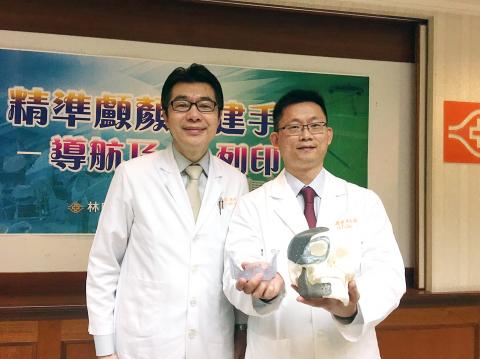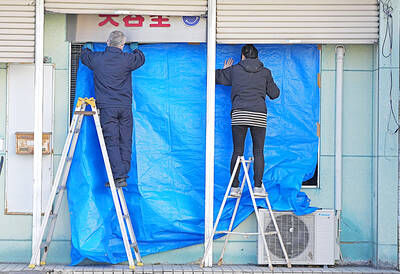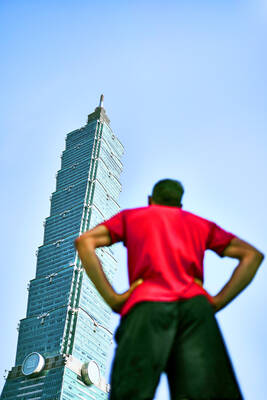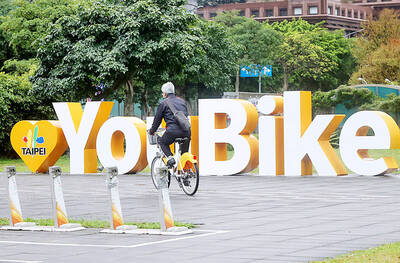A sculptor in his 50s whose cheekbone and eye socket were severely damaged in a motorcycle accident was able to return to work following reconstructive surgery that made use of a computer-assisted navigation system and 3D printing.
The artist, surnamed Peng (彭), crashed his motorcycle into the back of another vehicle, but did not seek immediate medical treatment, as he only noticed bruising, swelling and a feeling of numbness in his left cheek, doctors said, adding that he decided to apply ice and leave his injuries to heal on their own.
When the swelling subsided after about one month, Peng noticed that his face had become asymmetrical, with his left eye socket drooping, while his left cheek was still numb, doctors said.

Photo: CNA
Peng also began to notice blurred vision when he was sculpting, so he finally went to Linkou Chang Gung Memorial Hospital in New Taipei City, almost three months after the accident, doctors said.
An examination revealed that he had a displaced fracture of his left cheek bone and an orbital blowout fracture which had caused his eyes to become misaligned, one of his surgeons, Liao Han-tsung (廖漢聰) said.
The optimum period for performing surgery on cheekbone or orbital fractures is two or three weeks after the injuries occur, but as Peng delayed treatment, the bones in his face had set in a new place, making resetting them in their original positions difficult, Liao said.
With the help of a computer-based navigation system and 3D printing, doctors were able to construct a precise 3D model of the original bones and during surgery were able to avoid damaging sensitive organs or the optic nerves, which could have caused blindness, Liao said.
In addition, the technology allowed them to precisely reconstruct the patient’s appearance, he said, adding that in the past, the success of such efforts were hit and miss and depended on the surgeon’s ability.
The hospital has used the technology to help reconstruct the skulls or faces of about 150 patients, all of whom have been satisfied with the results, Liao said.

Taiwanese were praised for their composure after a video filmed by Taiwanese tourists capturing the moment a magnitude 7.5 earthquake struck Japan’s Aomori Prefecture went viral on social media. The video shows a hotel room shaking violently amid Monday’s quake, with objects falling to the ground. Two Taiwanese began filming with their mobile phones, while two others held the sides of a TV to prevent it from falling. When the shaking stopped, the pair calmly took down the TV and laid it flat on a tatami mat, the video shows. The video also captured the group talking about the safety of their companions bathing

US climber Alex Honnold is to attempt to scale Taipei 101 without a rope and harness in a live Netflix special on Jan. 24, the streaming platform announced on Wednesday. Accounting for the time difference, the two-hour broadcast of Honnold’s climb, called Skyscraper Live, is to air on Jan. 23 in the US, Netflix said in a statement. Honnold, 40, was the first person ever to free solo climb the 900m El Capitan rock formation in Yosemite National Park — a feat that was recorded and later made into the 2018 documentary film Free Solo. Netflix previewed Skyscraper Live in October, after videos

Starting on Jan. 1, YouBike riders must have insurance to use the service, and a six-month trial of NT$5 coupons under certain conditions would be implemented to balance bike shortages, a joint statement from transportation departments across Taipei, New Taipei City and Taoyuan announced yesterday. The rental bike system operator said that coupons would be offered to riders to rent bikes from full stations, for riders who take out an electric-assisted bike from a full station, and for riders who return a bike to an empty station. All riders with YouBike accounts are automatically eligible for the program, and each membership account

A classified Pentagon-produced, multiyear assessment — the Overmatch brief — highlighted unreported Chinese capabilities to destroy US military assets and identified US supply chain choke points, painting a disturbing picture of waning US military might, a New York Times editorial published on Monday said. US Secretary of Defense Pete Hegseth’s comments in November last year that “we lose every time” in Pentagon-conducted war games pitting the US against China further highlighted the uncertainty about the US’ capability to intervene in the event of a Chinese invasion of Taiwan. “It shows the Pentagon’s overreliance on expensive, vulnerable weapons as adversaries field cheap, technologically